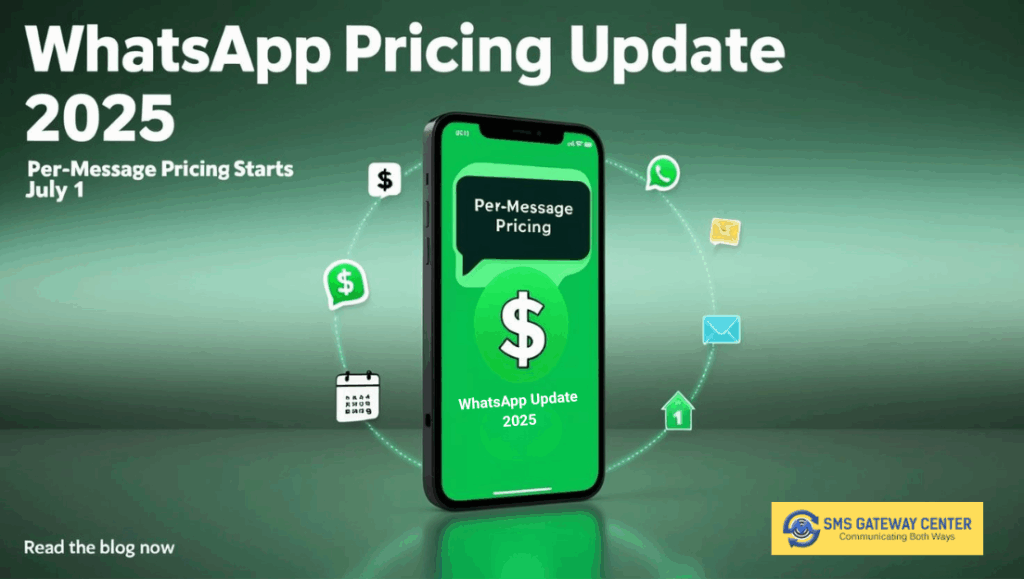Understanding Meta’s WhatsApp Business Platform Pricing Update: Per-Message Pricing Starting July 1, 2025
At SMSGatewayCenter, we’re committed to keeping our clients informed about the latest updates that impact your business communication strategies. Meta has recently announced a significant change to the pricing model for the WhatsApp Business Platform, shifting from per-conversation to per-message pricing starting July 1, 2025. This update aims to simplify costs, align with industry standards, and enhance the quality of messaging experiences for both businesses and customers. In this detailed blog, we’ll break down what this change means for your business, how it works, and how you can prepare to optimize your WhatsApp communication strategy.

What Is the WhatsApp Business Platform Pricing Update?
Meta is revamping the pricing structure for the WhatsApp Business Platform to make it more intuitive, straightforward, and aligned with the value it delivers to businesses and customers. Previously, WhatsApp charged businesses based on a per-conversation model, where a single fee covered all messages within a 24-hour conversation window. However, starting July 1, 2025, Meta will transition to a per-message pricing model for all businesses using the platform.
Why Is Meta Making This Change?
Meta’s goal with this update is threefold:
- Simplify Pricing: The per-message model eliminates the complexity of tracking overlapping 24-hour conversation windows, making it easier for businesses to understand and predict costs.
- Encourage High-Quality Messaging: By charging per message, Meta incentivizes businesses to send thoughtful, targeted messages rather than bulk, low-value communications, reducing spam and improving user experiences.
- Align with Industry Practices: Per-message pricing aligns WhatsApp with other messaging channels, simplifying ROI comparisons and helping businesses better evaluate WhatsApp’s value in their communication stack.
This shift reflects Meta’s commitment to delivering a pricing model that benefits both businesses and WhatsApp users by focusing on meaningful, value-driven interactions.
How Does Per-Message Pricing Work?
Starting July 1, 2025, businesses on the WhatsApp Business Platform will be charged for each delivered template message, depending on its category. Here’s a breakdown of the charges:
- Per Delivered Marketing Template Message: Messages sent for promotional purposes, such as offers, product updates, or campaigns, will incur a charge per message.
- Per Delivered Authentication Template Message: Messages used for user verification, such as one-time passcodes (OTPs) for login or account recovery, will be charged per message.
- Per Delivered Utility Template Message (Outside Customer Service Window): Transactional messages, like order confirmations or shipping updates, will be charged per message if sent outside a customer service window.
What Is a Customer Service Window?
A customer service window is a 24-hour period during which a business can send any type of message—template or free-form—to a WhatsApp user without incurring additional charges, provided the window is open. This window starts or refreshes whenever a user messages your business number. For example:
- A customer messages your business on May 17, 2025, at 03:54 PM IST to inquire about a product.
- A 24-hour customer service window opens, allowing you to respond with free-form messages or templates (like utility messages) without extra charges until May 18, 2025, at 03:54 PM IST.
If the customer service window is not open (i.e., the user hasn’t messaged you in the last 24 hours), you can only send template messages, and each delivered template message will incur a charge under the new pricing model.
Example of Per-Message Pricing
Let’s say your business phone number sends the following messages to a customer on July 1, 2025:
- A marketing template to promote a new product: “Get 20% off our latest collection today!”
- A utility template to confirm an order: “Your order #123 has been confirmed.”
- Another utility template to provide a shipping update: “Your order #123 has shipped and will arrive on July 3, 2025.”
If the customer service window is not open, this will result in 3 charges under the new pricing model:
- 1 charge for the marketing template message.
- 2 charges for the utility template messages (since they’re sent outside the customer service window).
However, if a customer service window is open (e.g., the customer messaged you first), the utility template messages would be free, and you’d only be charged for the marketing template message.
Benefits of Per-Message Pricing for Businesses
While the shift to per-message pricing may seem like a significant change, it offers several advantages for businesses using the WhatsApp Business Platform through SMSGatewayCenter:
- Clearer Cost Tracking: Charging per message simplifies budgeting, as you’ll know exactly how much each message costs without worrying about overlapping conversation windows.
- Better ROI Comparisons: Per-message pricing aligns WhatsApp with other communication channels (e.g., SMS), making it easier to compare the return on investment across platforms.
- Encourages Targeted Messaging: The model incentivizes businesses to send high-value, relevant messages, improving customer engagement and reducing the risk of being flagged as spam.
- Flexibility in Messaging Strategy: With a clearer understanding of costs, you can strategically plan campaigns, balancing marketing, utility, and authentication messages to optimize expenses.
How to Prepare for the Pricing Update
To ensure a smooth transition to the per-message pricing model starting July 1, 2025, here are some actionable steps your business can take:
1. Review Your Current Messaging Strategy
Analyze your current WhatsApp messaging patterns to estimate the volume of template messages you send monthly. Break them down by category:
- Marketing Templates: How many promotional messages do you send? Are they targeted, or do you rely on bulk blasts?
- Utility Templates: How often do you send transactional updates like order confirmations or shipping notifications? Are these typically within a customer service window?
- Authentication Templates: How many OTPs or verification messages do you send for user authentication?
Understanding your messaging volume and categories will help you predict costs under the new model.
2. Optimize Messages Within the Customer Service Window
Maximize the use of the 24-hour customer service window to reduce costs:
- Encourage user-initiated conversations (e.g., through Click-to-WhatsApp ads or website chat widgets) to open a customer service window.
- Send utility template messages within the window to avoid charges. For example, if a customer messages you on May 17, 2025, at 03:54 PM IST, reply with order updates or reminders within 24 hours to keep the communication free.
3. Refine Your Marketing Campaigns
Since marketing template messages will incur a charge per message, focus on quality over quantity:
- Segment your audience to send targeted promotions to users most likely to engage.
- Use compelling calls-to-action (CTAs) to encourage responses, which can open a customer service window for free follow-ups. For instance, a message like “Reply YES to claim your 20% discount!” can prompt a user response, allowing you to continue the conversation without additional charges.
4. Budget for Authentication Messages
If your business relies heavily on authentication messages (e.g., for OTPs or account verification), factor in the per-message cost:
- Check if your operations are affected by international authentication rates, especially if you serve customers in markets like India, Egypt, or the UAE.
- Optimize authentication workflows to reduce unnecessary messages, such as combining multiple verifications into a single message where possible.
5. Use SMSGatewayCenter’s Tools to Monitor Costs
At SMSGatewayCenter, we provide tools to help you track and manage your WhatsApp messaging expenses:
- Rate Plan Section: Check the WhatsApp tab in the Rate Plan section of your dashboard to view the latest per-message rates for marketing, utility, and authentication templates.
- Usage Analytics: Monitor your message volume and costs to identify areas for optimization.
- Support Team Assistance: Our team is here to help you navigate the pricing changes and adjust your strategy for maximum efficiency.
What This Means for SMSGatewayCenter Clients
As your trusted partner for Bulk SMS and WhatsApp Business API solutions, SMSGatewayCenter remains committed to helping you grow and scale on the WhatsApp Business Platform. Here’s how we’re supporting you through this transition:
- Transparent Pricing Updates: We’ll keep you informed about the latest WhatsApp rates and how they impact your account. Check your SMSGatewayCenter dashboard regularly for updates.
- Seamless Integration: Our platform is fully aligned with the WhatsApp Business API, ensuring your messaging workflows remain uninterrupted as the pricing model changes.
- Expert Guidance: Our support team is available to help you optimize your WhatsApp strategy, from crafting effective templates to managing costs under the new model. Reach out to us for assistance.
We’re excited to continue partnering with you to leverage WhatsApp’s capabilities for better customer engagement, whether you’re sending targeted marketing campaigns, transactional updates, or secure authentication messages.
Key Dates to Remember
- Now (May 17, 2025): Start reviewing your messaging strategy and preparing for the upcoming pricing change.
- July 1, 2025: Per-message pricing goes live for all businesses on the WhatsApp Business Platform. Ensure your campaigns and integrations are updated by this date.
Additional Resources
For more details on the per-message pricing model and WhatsApp’s official rates, refer to the following:
Conclusion
Meta’s shift to per-message pricing for the WhatsApp Business Platform, effective July 1, 2025, is a positive step toward simplifying costs and encouraging high-quality, value-driven communication. By charging per delivered marketing, authentication, and utility template message (outside the customer service window), this model gives businesses greater control over spending and aligns WhatsApp with industry-standard pricing practices.
At SMSGatewayCenter, we’re here to help you navigate this change and make the most of WhatsApp’s powerful features. By optimizing your messaging strategy, leveraging the customer service window, and using our tools to monitor costs, you can continue to connect and engage with your customers effectively while managing expenses.
Have questions about the new pricing model or need help adjusting your WhatsApp strategy? Contact our support team. Let’s work together to ensure your business thrives on the WhatsApp Business Platform!

